#because they cut out key jopson moments
Text
If one wanted to see the original AMC cut of The Terror (rather than the BBC version), where should one look?
#the links floating around at present seem to be the BBC version#because they cut out key jopson moments#and that's my blorbo right there so i need original flavor#thomas jopson#amc the terror#the terror#the terror amc
21 notes
·
View notes
Photo




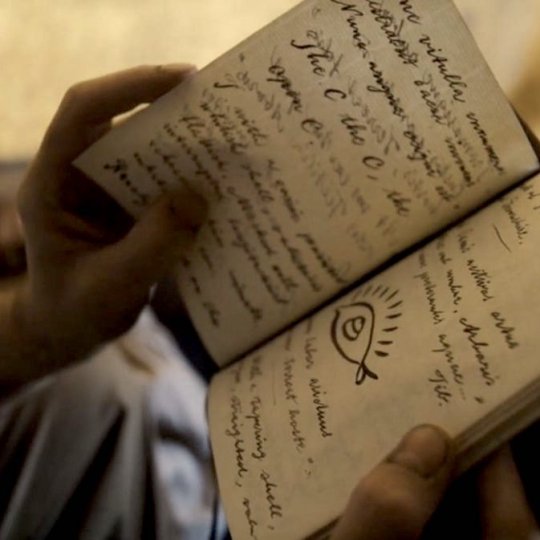




Bridgens/Peglar Egyptology AU
(for the @theterrorbingo square “modern AU” | word count: 1k fic + 1.5k AU details | rating: T | warnings: mild spooky; talk of mummies; description of a panic attack)
The Terrors are all members of the Classics (Greek & Roman Studies) department. The Erebites are all members of the Egyptology department. These two departments share the beautiful Barrow Hall building on the campus of their university, but they do NOT get along….
….until Henry Peglar, a first-year graduate student in Classics, decides that he wants to learn how to read Egyptian hieroglyphs.
(Drabbles and AU info below the cut!)
It turns out that most students who want to study hieroglyphs have already finished the introductory course, however, because Henry ends up in a tiny winter-term class with only two other students. The three “hieroglyph 101s” all show up a bit early to their first day of class, fumbling into a dimly-lit classroom in the basement of Barrow Hall, across from the archaeological store-rooms.
They exchange quick introductions while waiting for the instructor to arrive. Both of Henry’s classmates are undergraduate Egyptology majors: Tom Hartnell is a bright young freshman with a passion for Egyptian mummies (and, admittedly, a slightly spotty undergraduate record), and Henry Collins is a terribly anxious junior who recently switched majors from Engineering (“Please call me Collins,” he says, after Henry begins to comment that they share a name. “Everyone else already calls me Collins.”)
The moment of revelation for Henry Peglar, though, is when he first sets eyes on their instructor: a senior graduate student named John Bridgens, who walks in just a minute after the hour, with a thermos of what smells like mint tea.
John Bridgens looks almost mournful for a moment, his dark eyes soulful, a thick pea-coat sitting heavy on his shoulders (which he quickly shrugs off; it may be a chilly January outside, but Barrow Hall is toasty and warm). When John looks over to his students, though, he smiles, and his face is transformed: Henry feels like the sun has suddenly come out from behind the blustery clouds.
Henry quickly realizes that learning Egyptian won’t be like learning Greek or Latin, but fortunately John is a very good teacher. Even though John holds office hours at an ungodly hour of the morning, Henry shows up to every office hour with a bright smile and a long list of questions.
What Henry doesn’t yet know is that he’s in for the most exciting semester of his life…
(Featuring such hijinks as: John and his students Henry, Tom, and Collins get locked into the archaeological store-room with the mummies, in the dark! Henry and Tom Hartnell uncover a secret that could overturn the Egyptology department! Henry develops an unfortunate crush on his instructor! What could go wrong!)
+
“We’re Trapped in Here, Aren’t We?” (Bonus Drabble)
The four of them have now been locked in the basement, in the dark, for over an hour.
Collins is quietly freaking out, sitting on a storage crate in the corner of the main room of the museum storage space. Henry watches Tom Hartnell deftly trying to help Collins regulate his breathing to a pace approaching normal, with some success; Henry decides not to intervene.
“We’re trapped in here, aren’t we?” Collins asks. He doesn’t sound panicked anymore, just stressed; it’s an improvement.
Tom rubs Collins’s shoulder reassuringly, and says, “I don’t know for certain, but I’m not going to let it worry me – we’re going to be okay, alright?” Tom then turns to Henry Peglar and tilts his head, adding: “Eddie Hoar told me that there used to be a secret passage that ran between Barrow Hall and the library, and that the door opened up somewhere here in the storage-rooms. Maybe we can find it?”
Henry nods, flashes a grin that feels fake but must seem genuine in the low light of the storage-rooms’ emergency lighting, because Tom smiles back at him. “I’ll go check on John,” Henry says. “See if he doesn’t know anything about a tunnel.”
Slipping in between the shelves of Greek ceramics, Henry winds his way toward the back workroom where he left John Bridgens, who had been convinced that there must be an extra key somewhere in the workroom desk drawers.
Henry is so caught up in thoughts of tunnels that fails to notice the packing box sitting next to the shelves and he manages to trip right over it. He takes the fall hard, feeling the chilly linoleum under his now-aching arm, his eyes squeezed shut against the pain. When he opens his eyes, though, Henry feels a bolt of fear run though him – for a moment he thinks he’s gone blind, because he sees nothing but darkness. A moment later, the ancient emergency lights flicker back on, and that’s worse because Henry is face-to-face with the mummy.
Henry had forgotten that she was stored here, under the shelves of Egyptian faience. He distantly remembers Dr. Blanky pointing out “the Egyptian girl, our princess,” in her lovely painted coffin, on a tour through the storage rooms last year when he had been a prospective student – but the fact that she was down here (trapped with us, his mind whispers) had escaped his mind.
Shuddering, Henry pushes himself up from the cold floor and backs up against the wall as the lights keep flickering. He knows, he knows, that there’s nothing to fear here, but the sight of the girl’s skin, drawn tight against her skin, her eerie grimace, had shaken him.
“Henry?”
Henry jumps about a foot in the air, but it’s just John, peering out from the workroom door.
“Henry, are you okay?” John continues, his brow furrowed with worry.
Henry swallows. “Yup, yeah, just took a tumble.” He straightens up, tries to collect himself. “Did you find an extra key?” he asks John.
But John isn’t so easily dissuaded. “Are you sure you’re alright?” He steps up next to Henry, a hand hovering over the arm that Henry’s cradling to his chest (Henry’s certain it isn’t broken, but he knows it’ll be bruised a bit).
Henry looks up into John’s eyes and exhales softly to see the loving concern written there. John’s so close now, lifting a hand toward Henry’s cheek, and Henry wants this, wants to reach out and embrace; he finally feels his limbs stop shaking now that John’s here, even as his heart races and his face tilts up…
…. and that’s the moment when the emergency lights finally flicker their last, and the corridor goes dark as a tomb.
+
Some Background on the Humanities Departments of Barrow Hall
The Department of Classics
The Classics program at Barrow Hall is small but powerful. Most of the faculty get along well with each other, professionally, although they don’t socialize much. There aren’t many graduate students in the program, but most of the grad students they do have are quite active on the university campus.
Classics Faculty
Dr. Crozier is the department chair of the Classics program. He teaches early Roman history, with a focus on land surveying, and he takes a very scientific approach to his material.
Dr. Little is an associate professor who teaches Greek military history and gets very excited about ancient weapons. (“Like the shot that killed Leonidas at Thermopylae!”)
Dr. Hodgson is an associate professor who teaches Greek drama; he’s particularly obsessed with the tragedies of Euripides – the more ritualistic violence the better.
Dr. Irving is an assistant professor who teaches later Roman history, and can turn any conversation into a debate about the early history of Christianity. His most recent book was titled “Coming Out Christian in the Roman World: How the Followers of Jesus Made a Place in Caesar's Empire.” * Despite Irving’s own Christian faith and his social justice outreach work with the campus Queer Interfaith club, Irving’s a bit of a chronological traditionalist when it comes to academic research, and tends to dismiss any literature written after Augustine.
Drs. Peddie and MacDonald are actually part of the History Department, but because they teach Medieval Latin, they’re considered honorary members of the classics faculty. (MacDonald teaches a wildly popular undergraduate seminar – cross-listed with Classics and History – called “Witches, Ghosts, and Potions: Medical Mysteries in Medieval Europe.”)
Dr. Blanky is the exception to the “we hate the Egyptologists” rule – Thomas gets along quite well with a certain Dr. Reid, both of whom have a passion for film studies, and together they’ve organized a weekly historical film series for the undergrads. Dr. Reid’s top picks are old-school classics like Cleopatra (1963) and Julius Caesar (1953); Blanky, on the other hand, is partial to Gladiator (2000). He’s also the exception to the “this department doesn’t socialize rule,” being, himself, a long-time best friend of department chair Dr. Crozier.
Classics Grad Students
Thomas Jopson is an older graduate student – he’s just a breath away from receiving his PhD: Dr. Crozier, who has been supervising his thesis on the systems of enslavement in the Roman Republic and the lived experiences of Roman slaves, is extremely proud of Thomas’s sensitive eye for historical evidence. Thomas also works for the campus mental health office, leading a therapy group for adult children of those suffering from addiction.
Billie Gibson, another grad student, is part-way through writing his dissertation on the reception of Greek ideas about homosexuality in the Victorian period, under the supervision of a confused but supportive Dr. Irving. (“Isn’t this more of a History department topic?”)
“Hickey” started the PhD program at the same time as Billie, and he’s begun writing his thesis on cannibalistic imagery in Greek poetry with Dr. Hodgson. Everyone just calls him Hickey, and Henry Peglar hasn’t been able to figure out his full name (or whether “Hickey” is a first name or a last name, or even whether “Hickey” is part of his real name at all) because no one ever updates the Classics department website. Hickey is part of a student organization called the Dionysians, but they’re not listed on the university’s roster of sanctioned clubs, and no one seems to know what it is that they do, exactly.
Henry Peglar is the newest member of the department, a first-year grad student. He’s planning on studying depictions of ancient history in modern fiction, hopefully with Dr. Blanky, who also happens to be his first-year advisor.
The Department of Egyptology
The Egyptology program at Barrow Hall has been having some hiring problems in recent years. Not only did several older professors retire, but the young Dr. Gore decided to move into museum-work full-time and Dr. Fairholme was ‘poached’ by the rival Egyptology program at another university. As a result, the Department of Egyptology has been under-staffed, with too many grad students and too few professors, resulting in two controversial recent faculty hires.
Egyptology Faculty
Dr. John is the department chair of the Egyptology program. He teaches ancient Egyptian literature and has a rather old-fashioned perspective on middle Egyptian grammar.
Dr. Reid teaches courses on the history of archaeological discoveries in Egypt, and the culture of artifact (mis-)handling by European excavators. He’s friendly with Dr. Blanky in the Classics program, and he lovingly crafts discussion questions for the film-showings that he and Blanky run. (He’ll never admit it, but he secretly loves the 1999 Mummy movie.)
Dr. Stanley teaches classes on ancient Egyptian medicine. He’s known for his severe grading policies and for his impressive ability to ruin the fun of topic that involves things like magic spells and fever-demons and having sex with crocodiles.
Dr. Fitzjames is one of the two new faculty members, a dashing archaeologist with an impressive résumé of excavation in Egypt – although, as Dr. Crozier has wryly observed, some of his funding sources for those digs haven’t always been completely above-board.
Dr. Le Vesconte is the other new faculty member, an associate professor with an equally flashy history of excavation and publication. Rumor is that he and Dr. Fitzjames once found a live cheetah in an Egyptian tomb and tried to keep it as the excavation’s mascot.
Egyptology Grad Students
Edmund “Eddie” Hoar is a senior doctoral candidate, working dedicatedly on a massive dissertation about Egyptian stamps and seals. He’s been working with Dr. John because his old advisor recently retired, and with Eddie’s advisor gone, Eddie’s pretty much the only person on campus who knows his way around the dusty archaeological collection in the basement of Barrow Hall.
John Bridgens has been with the program about as long as Eddie, but he’s closer to finishing his thesis, a sprawling dissertation on Egyptian poetry under Dr. John’s supervision.
Charles “Freddie” Des Voeux is part-way through writing a thesis on Napoleon’s excavations in Egypt; his advisor is Dr. Reid. (He’s also roommates with Eddie Hoar, and the two of them are known as “(Fr)eddie” in the grad student group chat.)
Harry Goodsir is a first-year PhD student, who entered the program at the same time Henry Peglar started in Classics; the two of them met at the university-wide graduate student orientation, and Harry encouraged Henry to take hieroglyphs, which Harry had learned himself while he was an undergraduate, while volunteering with his siblings at an Egyptian museum in their hometown. Harry’s interested in Egyptian archaeology, hoping to study with Dr. Fitzjames and Dr. Le Vesconte, but there was a paperwork mix-up that placed Dr. Stanley as Harry’s first-year advisor (Harry is unhappy about it; Dr. Stanley is even more unhappy about it).
Members of Associated Departments in Nearby Ross Hall (& Their Drama)
Dr. James C. Ross is the co-chair of the anthropology program and a dear friend of Dr. Crozier in classics. Though he does have a complicated legacy with the university – being a descendent of the famous (if problematic) explorer, Sir John Ross, for whom Ross Hall is named – Dr. James is well-liked by his students and forward-thinking about his discipline.
Ross’s co-chair, Dr. Silna Kamookak, thinks Ross could stand to apply his anthropology to real-world problems a bit more intensively. Dr. Kamookak is a rising star in applied archaeology and she publishes on issues of museum collection ethics and heritage management; the graduate seminar she teaches on Inuit oral history documentation is known to be one of the best courses in the department.
Dr. Jane Franklin is the chair of English Literature; her research interests revolve around the writings of Charles Dickens. All the students in Barrow Hall call her “Dr. Jane,” and call her husband “Dr. John,” because neither would agree to let the other be called “Dr. Franklin.” A memo was circulated. It was messy.
Dr. Sophia Cracroft is an assistant professor in the History of Science department, and a frequent collaborator with Dr. Crozier in an ongoing interdisciplinary project about ancient cartography; although Dr. Cracroft has often tried to get Dr. John Franklin to permit a collaboration with the Egyptology department, Dr. John has always refused. Cracroft’s grad students say that it’s because Dr. John heard something “unsavory” about the relationship between Dr. Cracroft and Dr. Crozier. None of the grad students know what this “unsavory” thing is, but gossip ranges from the vanilla (an affair) to the bizarre (a papyrus smuggling ring).
Other Details
Goldner’s is a purveyor of textbooks of dubious quality. For some reason, all of the introductory language classes in both the Classics and Egyptology departments are always assigned Goldner’s textbooks, much to the students’ and instructors’ displeasure.
* “Coming Out Christian in the Roman World: How the Followers of Jesus Made a Place in Caesar's Empire,” is a real book! (It was not, however, written by John Irving.) I had a fantastic time reading it a few years ago – go check it out.
#theterrorbingo#first square!#based on real life accounts#(only partly I swear)#henry peglar#john bridgens#thomas hartnell#henry collins#the terror#the terror amc#terrorposting#mummies cw
32 notes
·
View notes
Text
something’s been nagging me about my earlier comments that Carnivale is mostly unimportant as a structural element in the overarching story of the Terror and I think I might have figured out at least something of why I was wrong
I don’t think I was wrong in dividing The Terror into two acts, with “First Shot a Winner” being the break: the first act concludes with Crozier’s decision to get sober; the second act opens with his struggles through withdrawal. That decision is the turning point of the plot, on both a character and a structural level. The fact that it is a decision is key: the first act is one of stasis, the second is one of praxis. They spend the first act literally locked in ice, doing fundamentally nothing, and the second walking out -- an action, a choice, and the second act is defined by both actions and choices. This transition, crucially, requires a choice from someone who is arguably one of the most static characters of the first act to prompt that change; and Crozier goes from being someone who is the least active (sinking further into an alcohol-fueled depression is rather the antithesis of action) to one who is the most.
So where does Carnivale fit into this? It is, as I argued last time, probably a very important character moment for both Fitzjames and Goodsir, but I have to qualify that with “probably” because we do not see these effects play out directly, we must infer them. Something has allowed Fitzjames and Crozier to become brothers, and I do not think that can be down entirely to Crozier’s risking his life for sobriety; something has changed on James’ end as well. Similarly, something has turned Goodsir from a man who has to be ordered to autopsy David Young into a man who can respond to a similar request to autopsy John Irving with a “good” that contains more viciousness then we have hitherto seen in all of Goodsir’s prior scenes put together. It is reasonable to assume that Carnivale was that something for both of them: it proved to Fitzjames that he was as fallible as anyone and knowing that it was a fellow doctor who killed so many must have been the first true blow against Goodsir’s faith in his fellow men. But again, we are not shown any of this; we are left to infer it.
So what role does Carnivale play, beyond these implied character moments? It is not, as it would be in many other shows, the major break between act one and act two; that has already happened. When it comes to the forward momentum of the plot, it changes nothing: they were already going to walk out. Instead, thematically and structurally, it is the prologue to act two, in the proper sense of the term: it tells you exactly what you will be seeing during the rest of the play. In fact, the entire episode is the prologue (much as, now that I am thinking about it, the first episode is the prologue to act one). Blanky’s description of the fate of the Ross expedition sets up the mutiny, Jopson’s care of Crozier sets up the choice of whether or not to abandon the sick, and Carnivale sets up, well, everything else, from the surreal disregard of their actual situation to the men “cooking” in a large pot to the repeated motif of a man chopping with an axe to Silna’s utter failure to control the Tuunbaq to it all ending with a betrayal and horrible death. It is also a prologue of action, and ends with action; compare that to “Go For Broke”, which is primarily a prologue of inaction (the most important moment is Crozier’s inability to change Franklin’s mind) and ends with the stasis of the pack.
I keep coming back to the episode title, “A Mercy”. I want to say that it is significant that this is the only episode in which the episode title is never said in the episode itself, although I have the sneaking suspicion that it probably originally was and just ended up on the cutting room floor, thus neatly negating my interpretation of said absence as thematically significant. Nevertheless, this is what we are left with, so I am going to go with it: in an episode where so much is left to the audience to infer, we are also left to infer the meaning of the title. A mercy, without more specific context, leads us to the conclusion that Stanley’s actions, coming as they were after Goodsir revealed to him the horrible secret of their food supply, were done because he believed killing them all by one of the most horrible ways for a human to die was better than the alternative. Was, truly, a mercy. Was Stanley in his right mind? No, of course not. He was a depressed bastard to begin with, and likely half mad from lead poisoning himself by that point. But, my point is, I swear to you I have a point here, he made a choice. A half mad choice, certainly, but that itself is also important: all the choices that will be made from here on out will be at least half mad. Walking out is the folly of a desperate man. But nevertheless, it was a choice, and a very deliberate action, and by doing so, by ending the prologue to act two with the grand set piece of Carnivale in flames, the writers have very clearly laid out the rest of the show for you: we are no longer trapped in the pack, doing nothing but drinking and getting preyed on by a half-seen monster. We are making choices now -- and they are, almost universally, the wrong ones.
#the terror#meta#sorry for the long post#but sometimes i do miss lj#of course i also miss having the time to write this kind of bullshit#which is not tumblr's fault#it is entirely my life circumstances that have changed since the days of lj#but nevertheless#i do miss lj and it's ability to have these kinds of conversations
63 notes
·
View notes
Text
The Fitzjames Sweater: a Terror conspiracy theory

Do you like your meta long and stupid? And full of not-really-mystery about a single item of clothing? Then boy do I have a meta for you; the center of which is James Fitzjames’ sweater—and the identity of its final owner.
(Half meta-analysis, half conspiracy theory, half absolute blithering nonsense under the cut, lads.)
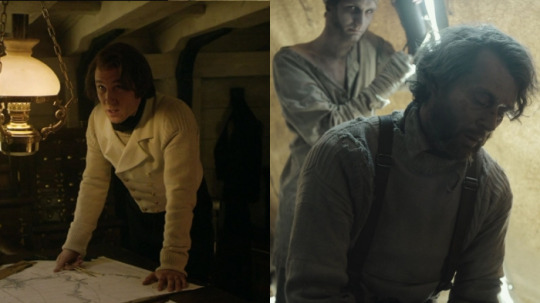
Now, this is a pretty distinctive sweater, especially in an expedition full of grey and navy arans. There are a couple of specific design elements (best outlined in knit-the-terror’s posts) that make it easy to identify The Sweater once it ends up on Le Vesconte: the side cables, the gansey-esque top and bottom, the ribbing patterns on the sleeves. The short neckband also visually distinguishes The Sweater from the cowl-necked white sweater Mr. Collins is wearing (also I think that one gets pretty soundly torn apart when Tuunbaq eviscerates him).
All of this is great and wonderful. However. What I’m most interested in is the cuffs.

These are double-length cuffs in a 1x1 rib with (perhaps anachronistically) a thumbhole knit in. Fitzjames wears the cuffs folded up most of the time, though if you turn up your brightness and squint you can spot that they’re all the way down at the time of poor Morfin’s death.
The garment construction appears to be such that sleeve was worked flat and them seamed into a tube—the thumbhole then just being part of the seam that wasn’t sewn up. (Why you would make a sleeve like this is beyond me—seaming sucks and it would literally be just as easy to add the thumbhole in when knitting in the round, but I suspect it has something to do with how they produced the no-doubt 10+ versions of this sweater they needed for filming.)
So, we’ve established some key characteristics of The Sweater that help us identify it. We’ve determined that it ends up on Le Vesconte after Fitzjames’ death. (Actually, Le Vesconte’s wearing The Sweater + waistcoat when Fitzjames collapses, so presumably James gives it away before then.) But can we show that anyone else has worn it? (Spoilers: sort of, but also yes.)
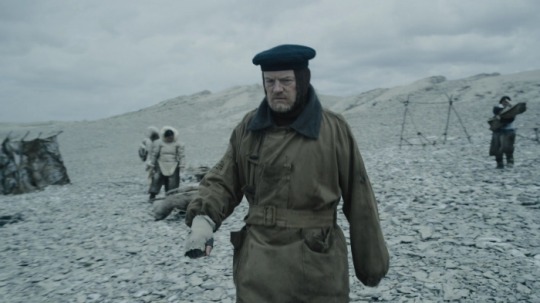
The morning after Silna leaves the Inuit village, when Francis is running around trying to figure out which way she went, he’s wearing the above outfit. His left hand is gone at this point, so his sleeve is tied up at the wrist, but there, covering his right hand… is an extra-long white sweater cuff with a thumbhole.

The image quality isn’t great here (the cameraperson decided to focus on the acting instead of a sleeve cuff for some reason) but when you look at all the angles next to each other, the resemblance is pretty obvious. Either there was always another long-cuffed white sweater on the Franklin Expedition that we are never shown, or Francis has at some point picked up The Sweater and is wearing it under his slops.

You can see a sliver of neckband underneath all his other layers in the picture above, just like with James.
Now, my main hurdle in 100% proof that this is The Sweater is, actually, also my most definitive proof: the thumbhole. (My gift and my curse…my blessing and my burden...)
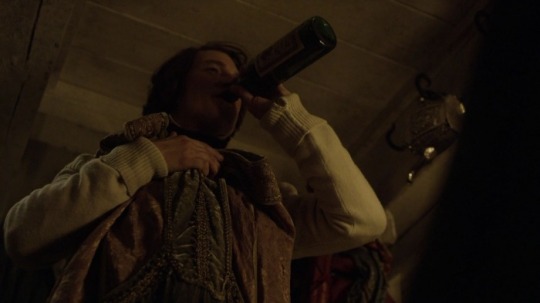
Assuming James hasn’t folded his cuffs to intentionally obfuscate, it’s pretty clear that each sleeve has one—and only one—thumbhole along the inside seam of the sleeve. It’s a logical assumption—I have no clue why you’d put a thumbhole on the outside of the sleeve because, like… that’s not where thumbs are.
By the time Francis is wearing the sweater it’s pretty beat up, so there are a number of noticeable holes in the cuff rather than just the one. (As we see from Le Vesconte’s shot at the beginning of this post, the rest of The Sweater is faring a pretty similar fate. My poor knitter’s heart is weeping.) While some of the holes have a fuzziness around the edges that indicates fraying, there’s still one hole with a cleaner, more finished edge that would indicate its identity as the real, intended thumbhole.

The problem is, it’s on the outside of the sleeve. Crozier appears to be sticking his thumb through another, accidental hole on the opposite side of the cuff. Even if The Sweater was worn inside-out and/or backwards, he shouldn’t be able to wear the thumbhole on the outside—at least, that’s what I thought. Then I tried putting on a sweater with only one hand. (It’s called field research, please don’t judge me.)
Basically, it’s really easy to get a sleeve twisted when you pull on a sweater, especially if it’s made to fit someone with a different physique. Without the opposite hand (or using your teeth, I guess), it’s basically impossible to untwist it, a difficulty that I imagine is compounded if you’ve already hooked your thumb through the cuff in the wrong place. I personally hate the feeling of a twisted sleeve, but Francis has just woken up in an unfamiliar place and honestly at this point in his life he might’ve just shoved the sweater on and called it a day.
Plus, we see the left cuff on Le Vesconte earlier and the thumbhole appears to be on the outside. The sleeves on this sweater are consistently Way Too Long, so it’s possible things just got twisted around whenever an actor would put it on and they left it that way for realism’s sake.
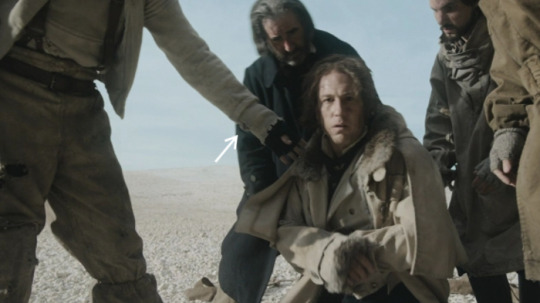
We don’t see Francis in it after the scene in the Inuit village, but like, even if The Sweater was still wearable after another two years, Francis is pretty well covered by his fur parka. (Also… just saying… the emotional implications of a moment where the last remnants of James Fitzjames unravel under his fingertips are uh… pretty juicy.
James has holes in him and so does his sweater.)

So! I think it’s fair to say that, at the very least, the sweater Francis is wearing is supposed to be the Fitzjames Sweater, as shown to the best of my ability (and screencap resolution). I won’t call it “beyond a doubt” but I think it’s a pretty strong foundation—which is good, because here is where my knit-wear based fever dream starts to, uh, unravel.
My initial assumption after realizing Crozier had the white sweater at the Inuit village was that he pulled it off Le Vesconte after Little’s death. (And idea which cannot help but conjure the morbid image of Crozier undressing a body beset by rigor mortis with one hand…. Or asking Silna for help.)
The tangle in this theory is that I went back and looked at the first few “travelling with Silna” scenes, initially for proof that Francis doesn’t pick up The Sweater until the Little Camp—and found the opposite.
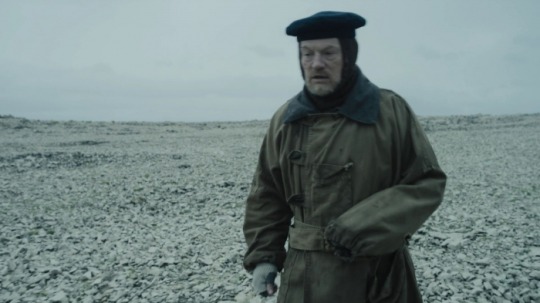
There’s no sign of The Sweater on Francis before the Tuunbaq showdown, but he has somehow acquired The Sweater before finding the body of Le Vesconte. The same identifying features I’m using for the end scene are all there, so. Can’t really deny that. (The best view we get is from the sad dead Jopson hair stroke, which also dates the timeframe a lot better then an ambiguous “Crozier walking around” screenshot.)
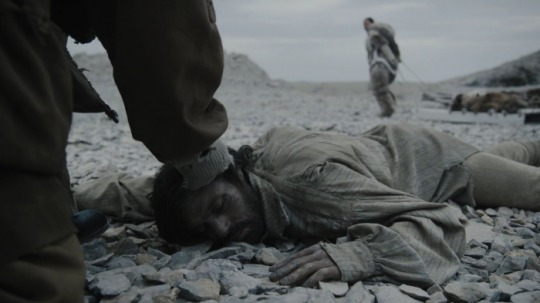
(For what it’s worth, the thumbhole arrangement appears to be done properly this time. Or at least, the hole on the outside of the arm is the frayed “accidental” thumbhole.)
To clarify the timeline:
Fitzjames has The Sweater.
At some point before James collapses, Le Vesconte acquires The Sweater.
Francis is kidnapped by Hickey’s camp. He does not have The Sweater, or at least not visibly.
Le Vesconte (and sweater) leave the sick (including Jopson) behind and head off toward the eventual Little camp.
Tuunbaq showdown. Francis spends some time in recovery.
We can assume that at some point during this bullet point or the next Le Vesconte and buddies die.
Francis and Silna leave the Hickey camp, find the abandoned men and sad dead Jopson. Somehow Francis has acquired The Sweater.
After this, Francis and Silna find the Little camp, presumably including a dead Le Vesconte and The Sweater.
(You could argue that Le Vesconte actually ended up staying with the sick but Francis’ is wearing the sweater when he first sees Jopson so he would have had to have it before finding them.)
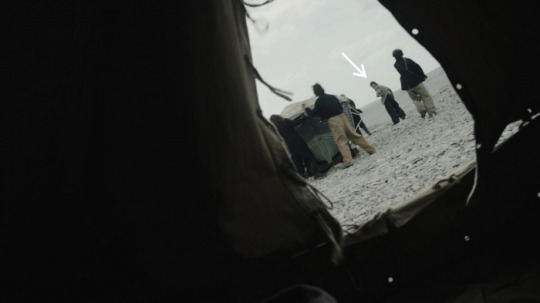
(Also, I have suspicions that this figure leaving the sick camp is Le Vesconte.)
So! There is an indication that, at the same point in time, both Crozier and Le Vesconte(‘s body) were wearing a version of The Sweater. If from this point forward we consider the sweater Fitzjames is seen wearing to be the “true sweater” and the extra to be the “double sweater”, then I see four possibilities:
Option One: Francis already had the sweater double.
Points in favor:
This gives the fun image of Crozier and Fitzjames showing up to the expedition on day one and staring horrorstruck at each other like “we wore the same dress!??!!”
You change. No you change! No you change!!!
Points against:
We see Francis in all kinds of informal dress and never see him wearing it. I’m not actually sure we ever see him wearing a sweater, period. Man hates being cozy, I guess.
There is literally no way costume design would have done this. Like, it beggars belief.
Option Two: Someone else (at the Hickey camp) had an eerily similar sweater that Crozier felt justified in taking.
Points in favor:
It doesn’t show up until he and Silna go back to the Hickey camp, so it’s unlikely that he would have gotten it earlier and just been carrying it around without wearing it.
They did seem to just leave all their stuff lying around, so Francis wouldn’t have to pull it off a dead body, which is a lot more palatable.
If the sweater was a standard “baby’s first officer sweater” present, Hodgson could be a candidate for the true owner.
Points against:
“Baby’s first officer sweater” is just like… not a thing the Victorian Royal Navy did. Also, we never see any of them wearing it, so.
Why wouldn’t the owner have worn it to the Tuunbaq showdown? I get that they’re all wandering around in their shirtsleeves but if someone had a sweater that was remotely still wearable, I feel pretty confident in thinking they aren’t just going to leave it lying around.
Option Three: Actually, Le Vesconte’s sweater is the double.
Points in favor:
Obviously Henry and James got them as best friends forever tokens and whenever they notice they’re wearing them at the same time they spend like, two minutes just hugging each other and saying “bro. bro. bro!”
It absolutely infuriates Francis.
This implies that Francis (or possibly a Hickey camp member but uh… unlikely) got ahold of the Fitzjames version after his death. James isn’t wearing it when he collapses (god… think of the blood stains…), so it would have been as easy as packing it up once he’s dead.
Francis is either in slops or in shirtsleeves after this point so if he keeps the cuffs folded up and his slops collar buttoned (which he does) then we might just not have seen it?
Even if we assume Le Vesconte’s sweater is a different one, there’s still pretty strong evidence James wasn’t buried in his sweater—see the above point, and also the fact that it doesn’t later show up on Hickey’s person. That’s a nice sweater, man, even if it’s fraying, and if I were already stealing a dead man’s boots I would’ve taken the sweater too.
Points against:
Le Vesconte is wearing The Sweater when James collapses—Fitzjames, notably, isn’t. (James mentions the heat as a reason why he can’t keep walking, so he might just not have been wearing it?)
God, guys, I don’t know that much about the Victorian knitting industry but the idea of two bros going out and getting matching sweaters seems… implausible at best.
Option Four: Making a TV show is hard and keeping track of all the details is harder and someone just accidentally put Jared in the sweater five minutes of screen time too early and we were past the time for reshoots and just assumed that no one would be neurotic enough to notice this.
Points in favor:
Script supervisor is like, a really hard job and if this is your biggest slip up then honestly? Who even cares.
Points against:
I care. I care very much.
But which option could be the truth? What conclusions have we formed from this tedious trek across the frozen wasteland of HD screencaps? What horrors have we (me, literally just me) wrought in the name of split-second costume design based character choices? Could Crozier have somehow gotten The Sweater from Le Vesconte after Tuunbaq dies but before reaching Little’s camp? Is there another, actually viable explanation for the mystery of the twin sweaters? How many good fics/headcanons could come from any of these options? I don’t know! Please discuss!
(For however much it matters: my personal favorite is Option Four. None of the others seem a terribly plausible story justification, and also I like the emotional weight of Francis picking up the sweater as a memento of JFJ—or the intention of it, even if continuity gets a little screwy.
Also, if no one writes fic about this then I will be forced to and who really wants that?? Write this fic for me and save us all the turmoil.)
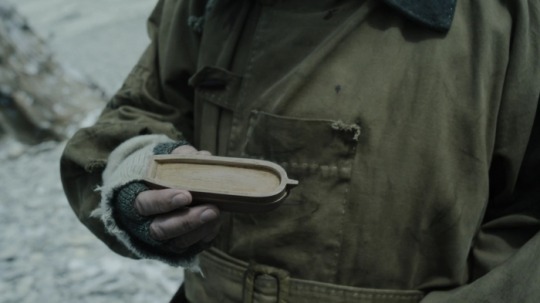
(A thousand props to @knit-the-terror for sussing out enough details that I could even make an argument focused around the cuff of a sweater. Please forgive my corrupting your research for a frantic fever dream rant about something that mostly doesn’t matter.)
#this is my magnum opus and my greatest shame#the terror#meta analysis#james fitzjames#henry le vesconte#francis crozier#that sweater lasts longer than most of the cast#and I love it just as much
386 notes
·
View notes